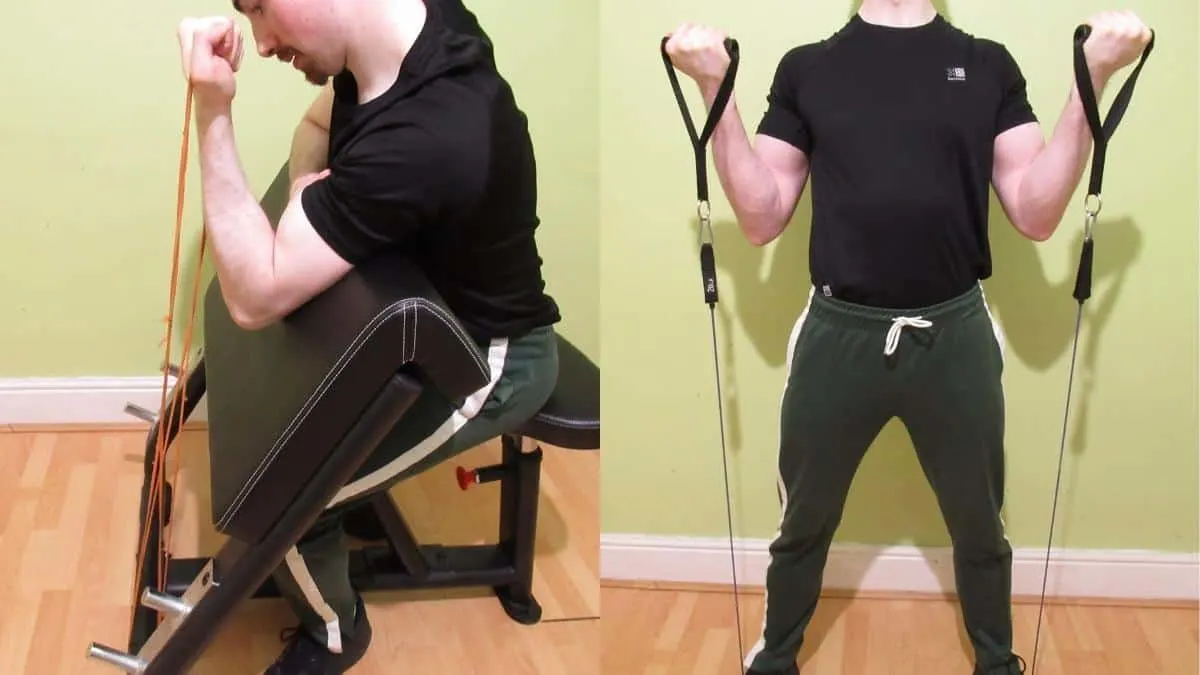This training guide provides a selection of the most effective resistance band bicep workout routines that you can perform to get in shape. So whether you want to build slabs of mass or sculpt a more slender and toned physique, you’ll definitely find the right program to develop your bicep brachii.
In addition to full workouts that you can perform anywhere, you’ll also find our list of the top 7 best resistance band bicep exercises for hypertrophy.
Related: Tricep resistance band workout
Top 7 best resistance band bicep exercises
These bicep band exercises are convenient yet highly effective for achieving muscular arms. Only one of the movements uses extra equipment (and even then, it’s optional); the rest you can perform absolutely anywhere.
1. Bicep curls
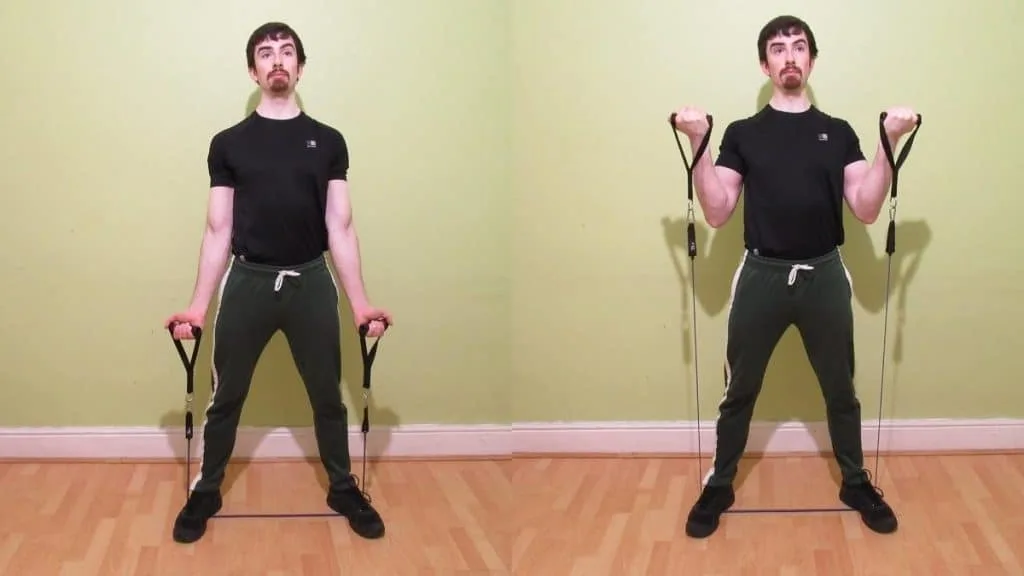
Performing bicep curls with resistance bands couldn’t be simpler. All you need to get those bicep gains is a band with handles and a tiny amount of workout space.
The exercise is also highly versatile because you can increase or decrease the band tension on the fly without messing around with cumbersome weight plates or even swapping the band. For example, if you shift your feet away from the middle of the band toward the ends, you’ll pull the slack out of the band and make it heavier.
Similarly, if you stand right in the center of the band, then you’ll still get a great bicep contraction, but there will be less tension during the initial part of the repetition, where you haven’t yet had a chance to pull the slack out of the band.
- Stand in the middle of the band.
- Grab the handles with an underhand grip and hold them by your sides.
- Curl the handles toward your shoulders.
- Keep lifting until the undersides of your forearms make forceful contact with your biceps.
- Hold the contraction for a moment and then lower the handles under control until your elbows are fully locked out.
- Repeat for 3-5 sets of 12-25 reps.
2. Drag curls
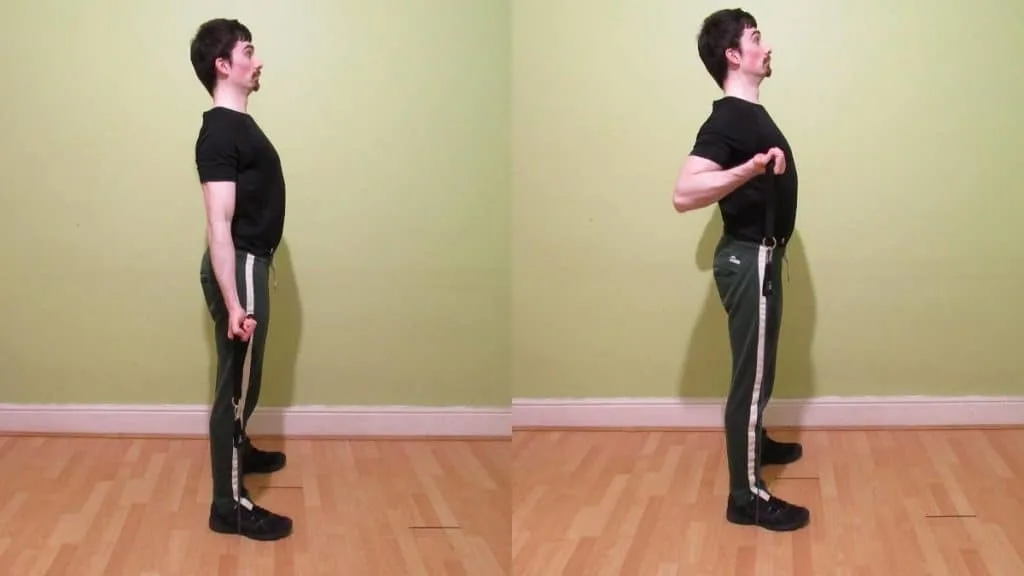
Resistance band drag curls make a great addition to any bicep band workout because they target the long head of the biceps, which is an area that many lifters want to improve seeing as developing it can result in a more prominent bicep peak.
The reason for the long head emphasis is that you’re curling with your elbows behind your torso. This positioning biomechanically shifts more of the tension onto the outer muscle fibers of your biceps because only the long head crosses the shoulder joint.
Just make sure that you don’t cheat by shrugging the band up. While it’s okay to feel a moderate amount of trap activation due to the fact that you’re performing somewhat of a rowing motion with your elbows, you should still feel the majority of the tension in your biceps.
A quick pro-tip in this regard is to think about moving your forearms toward your biceps while simultaneously dragging your elbows backward.
- Stand in the centre of your band and hold the handles by your sides with a supinated grip.
- Depress your scapula (basically the opposite of a shrug).
- Drag the handles upward in a straight line by moving them toward your biceps while simultaneously allowing your elbows to drift back.
- Squeeze your biceps forcefully as they make contact with your forearms.
- Hold the contraction for a moment and then slowly return the handles to the starting position by your sides.
- Repeat for 3-5 sets of 12-25 reps.
3. Reverse curls
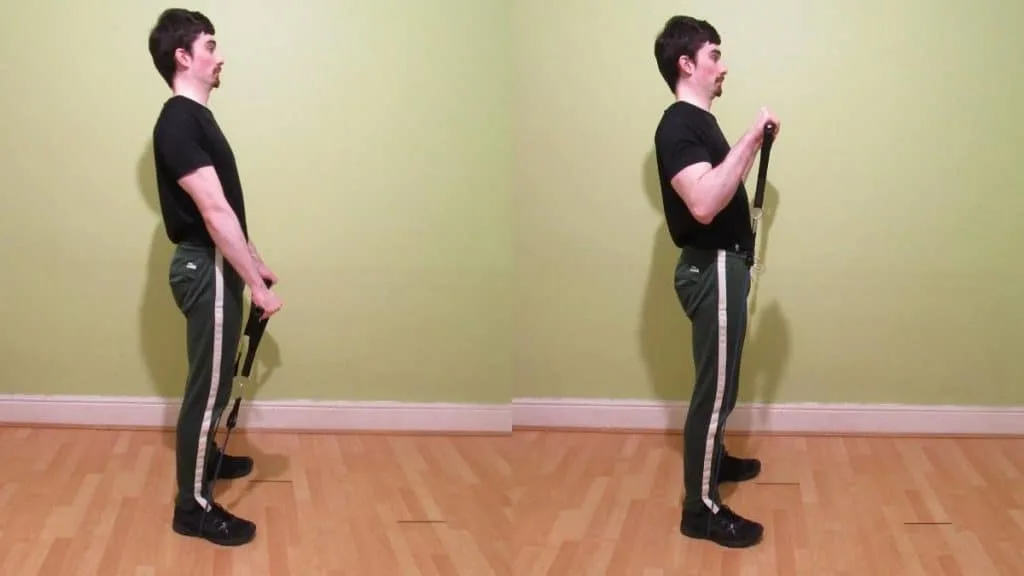
While the resistance band reverse curl may well be a brachioradialis-first, biceps-second movement, it’s no less effective for developing aesthetic arms.
Reverse curls are, in fact, one of the most effective resistance band biceps exercises that you can do because they train the two arm muscles that most lifters neglect, namely, the brachialis and the brachioradialis.
Both of these muscles are powerful elbow flexors, each of which becomes more active when you place the biceps in a position of mechanical disadvantage (i.e., when you curl with a pronated grip).
- Stand in the middle of a band to secure it to the floor.
- Grab the handles with an overhand grip and hold them by your sides, elbows locked out.
- Curl the handles toward your front delts while keeping your elbows still.
- Keep curling until the tops of your forearms press right up against your biceps.
- Hold the contraction for a second and then lower the handles until your elbows are once again extended.
- Perform 3-5 sets of 12-30 reps in total.
4. Preacher curls
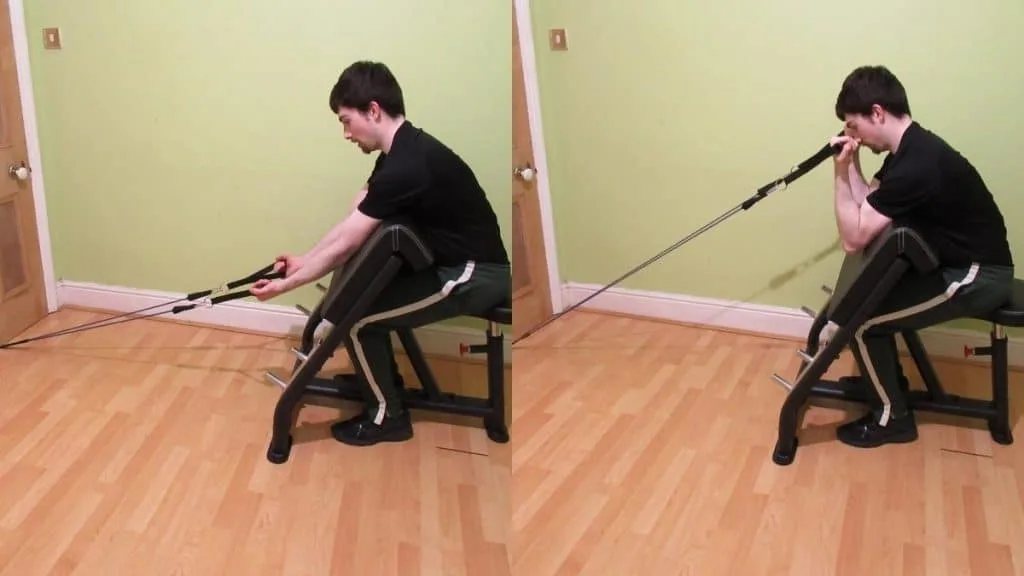
Believe it or not, you can do preacher curls with resistance bands, and you don’t even need a preacher bench!
The only requirements are a band with handles and a place to attach it. For most of us, this means attaching our band to a door anchor, which is widely available with many resistance band sets, and then looping the anchor under the door.
While this particular bicep band workout doesn’t have you lift in the usual preacher curl position, the feel of the exercise is exactly the same (if not better) because you’re bracing your elbows against your knees, which essentially mimics a preacher pad.
If you’re wondering why the resistance band concentration curl hasn’t been mentioned yet, it’s because the preacher curl already produces an intense concentration curl-like contraction. There’s no need to perform two bicep exercises with bands (especially not within the same workout) that do the exact same thing.
- Anchor your band under the door.
- Grab the handles with an underhand grip and take a few steps away from the attachment point.
- Sit up straight and shuffle your feet toward your hips.
- Brace your elbows against your knees.
- Curl your hands toward your front delts until your biceps are maximally contracted.
- Slowly release the contraction by letting the bands stretch your biceps until you reach full elbow extension.
- Repeat for 3-5 sets of 12-25 reps.
5. Spider curls
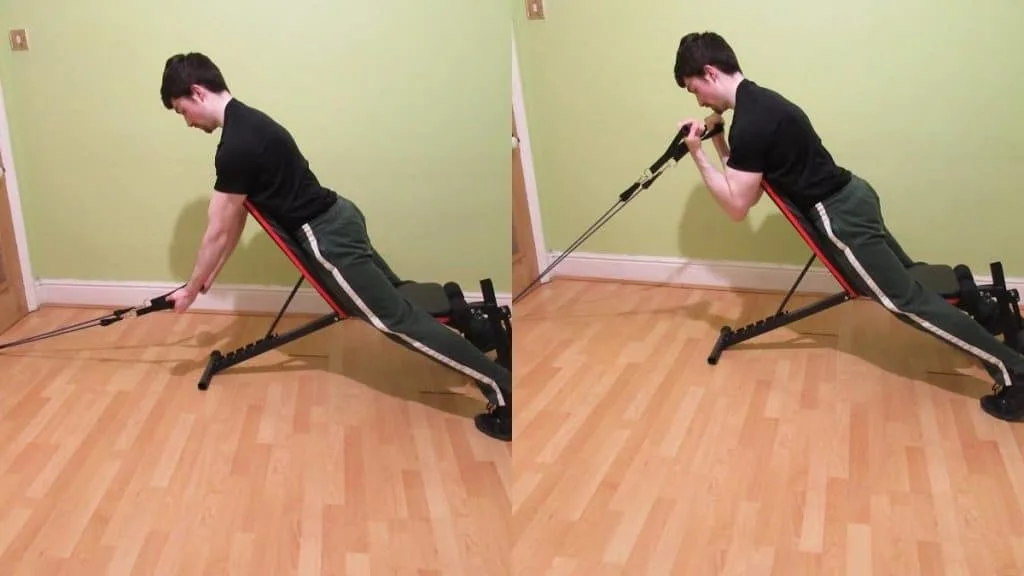
Whenever I do a bicep workout with bands, I always make sure to include spider curls because they create an intense peak contraction that’s hard to replicate elsewhere.
There are two ways that you can do spider curls with bands. The first and most straightforward method is to simply mimic the spider curl position by grabbing the bands, bending over at the waist, and then letting your arms hang down and in front of your body. From there, you simply perform the usual curling motion.
The other way is more complicated, but it will make your resistance band biceps workout feel more familiar if you’re heavily accustomed to training with free weights. This is the method you’re going to learn now.
You can also do a resistance band incline curl by sitting on the bench in a regular position, which, contrary to the short head-focused spider curl, places more tension on the long (outer) head of your biceps.
- Secure your bands to an anchor point (i.e., under a door or to the frame of a power rack).
- Wheel a bench a couple of feet away from the anchor point.
- Sit on the bench in a reverse position with your chest pressed against the backrest.
- Reach down and grab the band handles with a supinated grip.
- Curl the handles toward your shoulders until the undersides of your forearms forcefully press up against your biceps.
- Hold the contraction for a moment and then slowly lower the handles until your elbows are completely locked out.
- Perform 3-5 sets of 12-25 reps in total.
6. Zottman curls
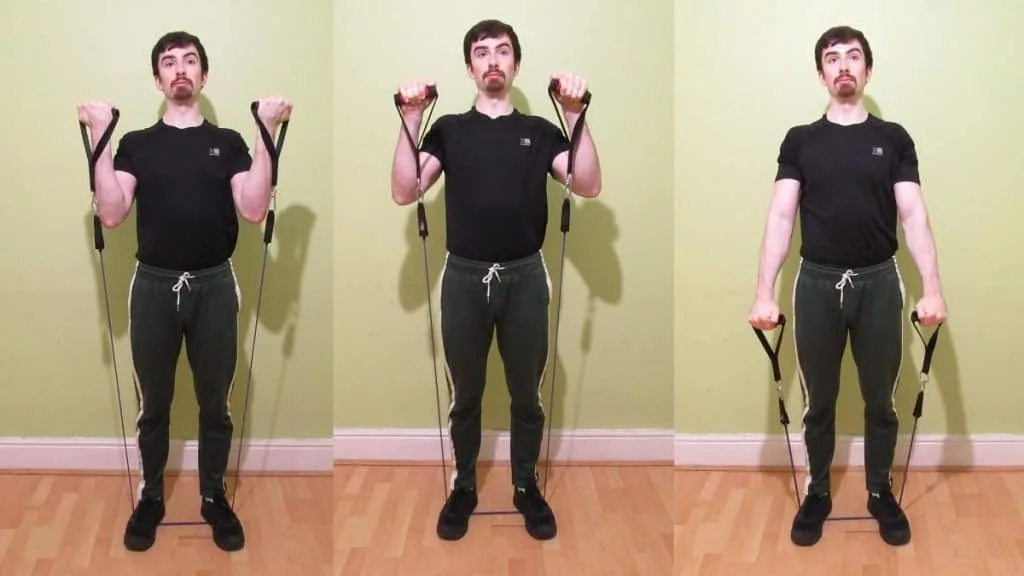
If you’re doing bicep workouts with bands but still want to train your brachialis and brachioradialis muscles as well, then you should definitely perform Zottman curls with resistance bands.
This movement is an excellent mass-builder because you’re using the combined strength of all your arm muscles during the concentric to overload your brachialis and brachioradialis with extra resistance—more than they could handle on reverse curls—during the eccentric phase of the rep.
It’s recommended to do this exercise with a single resistance band so that you can more easily rotate your hand at the top of the rep.
If you choose to use bands with handles instead, make sure to use a thumbless grip so that you don’t obstruct your hand’s ability to rotate at the halfway point of the movement.
- Double-loop a light resistance band by wrapping it around your foot twice.
- Hold the other end by your side with a thumbless underhand grip.
- Curl the band toward your shoulder.
- Keep lifting until your biceps and forearms make contact.
- Once your biceps are maximally contracted, rotate your hand so that you’re now holding the band with an overhand grip.
- Lower the band slowly until you reach full elbow extension.
- Turn your palm back to the original supinated position in preparation for the next rep.
- Repeat the movement with your other arm and do 3-5 sets of 12-25 reps per side.
7. Hammer curls
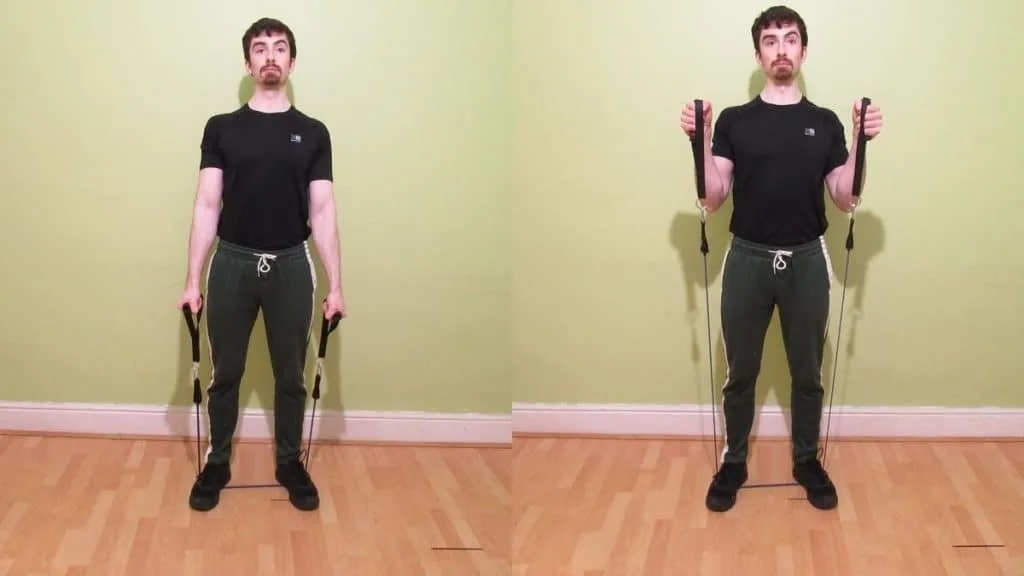
Resistance band hammer curls absolutely blast your brachialis and brachioradialis and, as such, make a great addition to any bicep resistance band workout.
This is because many lifters already have good biceps but comparatively worse brachialis and brachioradialis development. So any opportunity to improve these often lagging muscles is always a welcomed one.
Again, you can perform this drill with bands that have handles, which will save time since you’re training both arms together. However, in order to get a better grip on the band, it’s recommended to use a thin resistance band and train each arm separately if possible.
- Double-loop a resistance band by wrapping it around your foot twice.
- Hold the other end with a neutral grip.
- Lift the band toward your front deltoid while keeping your elbow still.
- Raise the band until your biceps and forearms make strong contact.
- Hold the contraction for a second and then slowly lower the band until your elbow is fully locked out.
- Repeat the exercise with your other arm and perform 3-5 sets of 12-25 reps per side.
Resistance band bicep workout routines
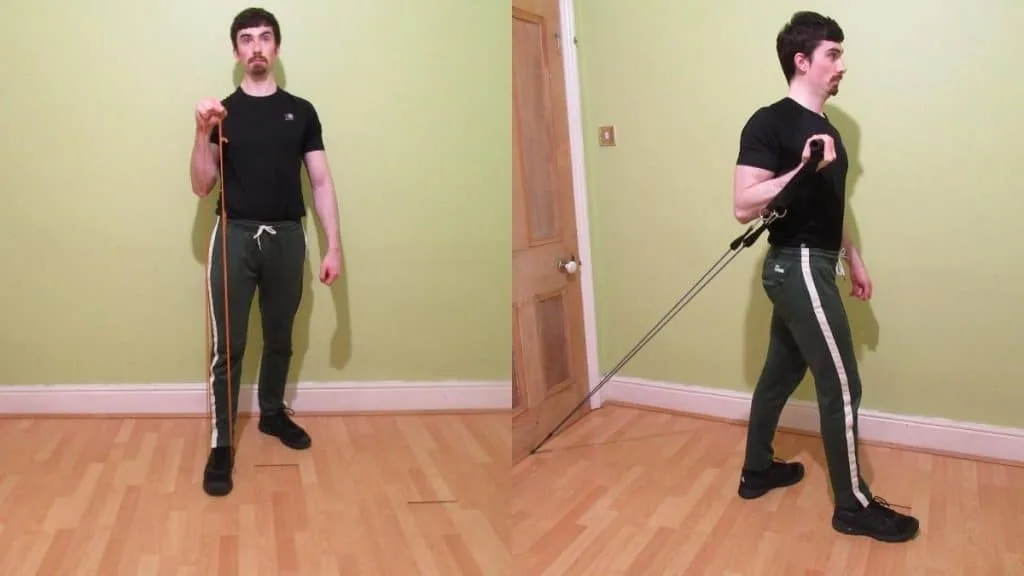
These three routines all cater to slightly different goals. For example, doing the first of these bicep workouts with resistance bands will make your biceps stronger, but its main focus is stimulating maximum muscle growth.
Likewise, the second of the resistance band bicep workouts will still trigger hypertrophy, but it’s primarily designed to make your biceps as strong as possible.
And finally, if you just want to get your pump on and get those veins popping, our third band bicep workout will definitely test your lactic acid tolerance.
Workout 1: Muscle growth
1: Preacher Curls — 3-4 sets of 12-15 reps
2: Reverse Curls — 3-4 sets of 12-20 reps
3: Drag Curls — 3-4 sets of 15-25 reps
4: Zottman Curls — 2-3 sets of 15-25 reps
Workout 2: Strength
1: Standing Curls — 4-5 sets of 10-15 reps
2: Hammer Curls — 3-4 sets of 10-15 reps
3: Zottman Curls — 3-4 sets of 12-15 reps
Workout 3: Maximum pump
1: Spider Curl — 3 sets of 20-30 reps
2: Drag Curl — 3 sets of 20-30 reps
3: Reverse Curl — 3 sets of 20-30 reps
Conclusion: How to maximize your next bicep resistance band workout
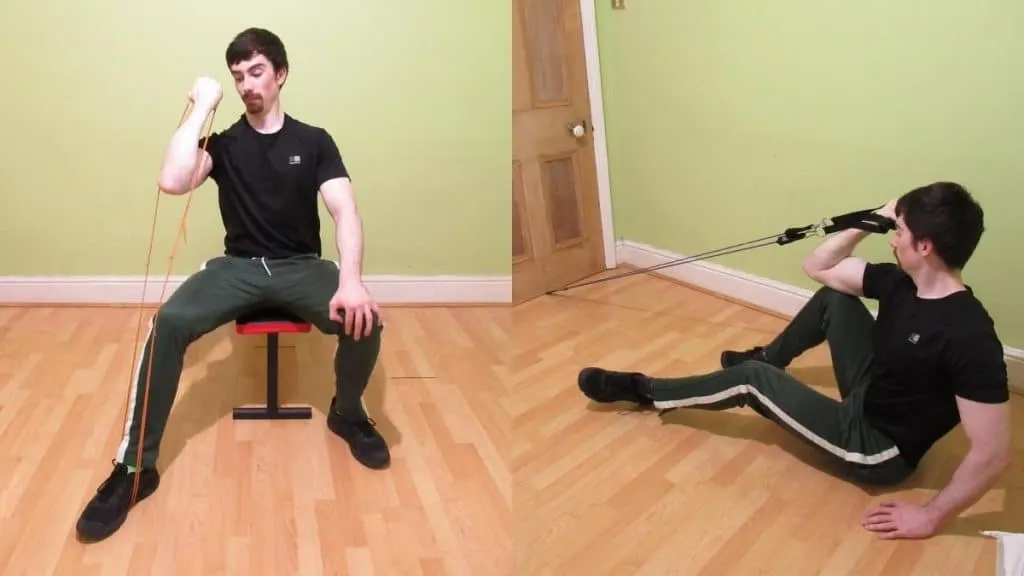
The first step to maximizing your next resistance band bicep workout is to evaluate your goals. Do you want to maximize your muscle growth? Get as strong as on ox?
If making your biceps larger is your primary goal, then our first bicep resistance band workout is the best option because it has plenty of training volume to stimulate new growth. It also includes the most amount of exercises, which means that you’ll be recruiting more muscle fibers by working your biceps from different angles.
Our second workout included fewer resistance band bicep exercises so that you can recover faster and thus gain strength quicker. It also makes use of lower reps so that you can get used to handling heavy weight even though you won’t actually be lifting anything other than rubber!
References
- Burhan, N., Kasno, M. A., Ghazali, R., Said, M. R., Abdullah, S. S., & Jali, M. H. (2017). Analysis of the Biceps Brachii Muscle by Varying the Arm Movement Level and Load Resistance Band. Journal of Healthcare Engineering, 2017, 1–8. https://doi.org/10.1155/2017/1631384
- Quinn, E. (2021, April 29). Improving High-Intensity Endurance With Lactate Threshold Training. Verywell Fit. https://www.verywellfit.com/lactate-threshold-training-3120092

